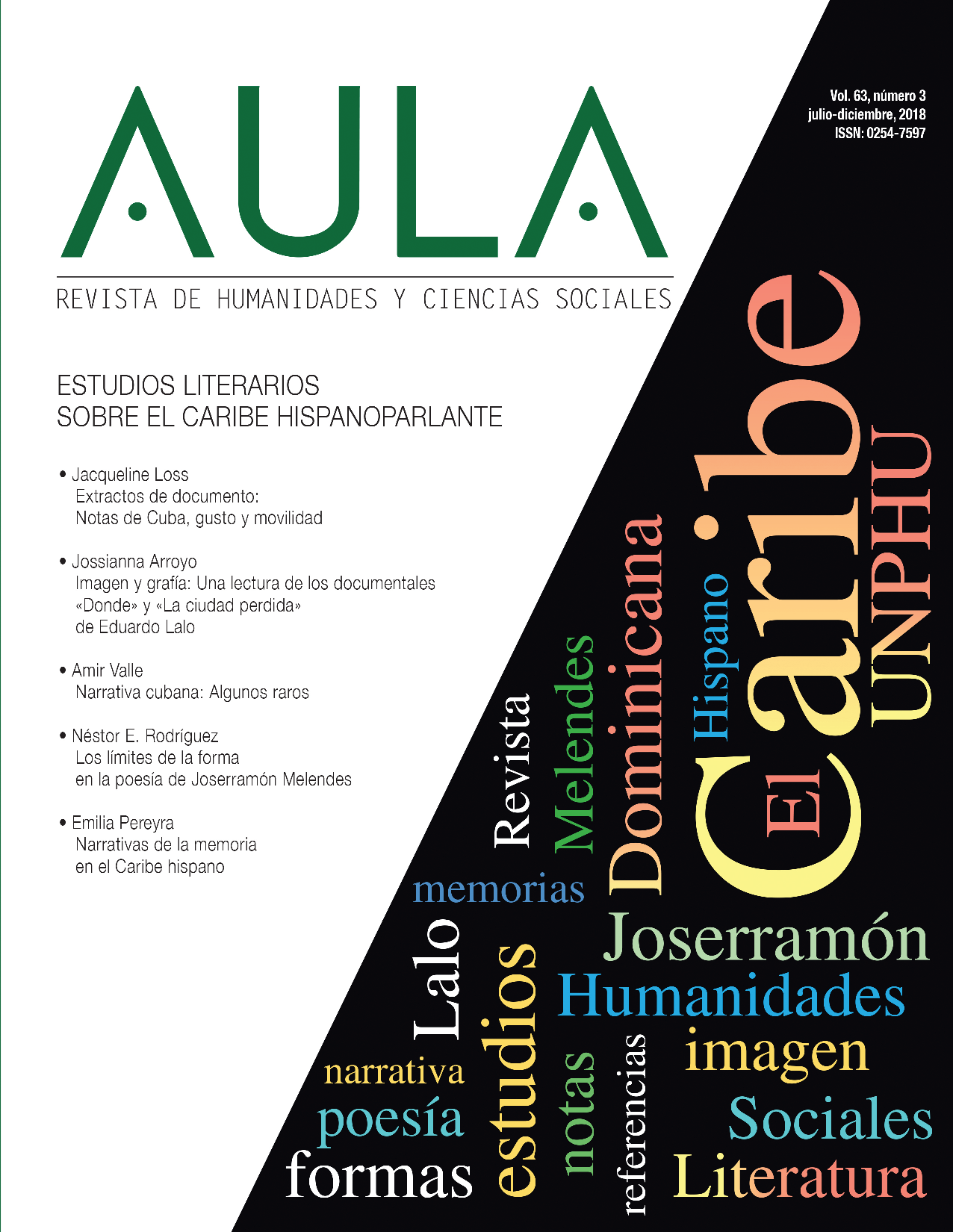Image and script: A reading of the documentaries "Donde" and the "Ciudad perdida" by Eduardo Lalo
Published 2019-01-17 — Updated on 2023-06-01
Versions
- 2023-06-01 (3)
- 2023-01-13 (2)
- 2019-01-17 (1)
Keywords
- Caribean,
- city,
- globalization,
- Lalo,
- videoproductions
How to Cite
Copyright (c) 2023 AULA Revista de Humanidades y Ciencias Sociales

This work is licensed under a Creative Commons Attribution 4.0 International License.
Abstract
This essay is an analysis of two video productions by Puerto Rican writer Eduardo Lalo (1960),
Donde and La ciudad perdida and how they represent the global city or global cities of the Puerto
Rican archipelago. If in Donde there is an autobiographical element, where we look at the impossibilities
of return, in La ciudad perdida Lalo honors the diverse cityscapes of San Juan. Videometraje
a term coined by Lalo reveals a complex way of looking. In both productions, the writer’s exile,
the "insilio" (internal exile) join together with the ruins of the global present to write in a creative
fashion, diverse and intimate geographies of the cityscape.
Downloads
References
- Agamben, G. (2003). The Open: Man and Animal [La apertura: hombre y animal]
- Arroyo, J. (2015). Cities of the Dead: Performing Life in the Caribbean [Ciudades de los Muertos: Interpretando la vida en el Caribe]. Forum, 46(2), 35-40.
- Avilés, F. J. (2012). Estética del derrumbe: escritura y deambular urbano en la obra de Eduardo Lalo. Revista Iberoamericana,78(241), 873-892.
- Barthes, R. (1980). Camera Lucida. Reflections on Photography. McMillan.
- Benjamin, W. (2002). The Arcades Project [El Proyecto Arcades]. Belknap Press.
- Bennett, J. (2010). Vibrant Matter: A Political Ecology of Things [Materia vibrante: una ecología política de las cosas]. Duke University Press.
- Dávila, L. (2014). Verlo. Leerlo. Eduardo Lalo frente a la escritura fotográfica latinoamericana. Revista Iberoamericana, 80(247), 653-675.
- Duchesne Winter, J. (2009). Desde donde alguien: la política del no-lugar en Eduardo Lalo. En Comunismo literario y teorías deseantes (pp. 65-89). Plural.
- Duchesne Winter, J. (2010). Sobre Eduardo Lalo, Los países invisibles. Revista Iberoamericana, 75(229), 1288-1292. https://doi.org/10.5195/reviberoamer.2009.6636
- Foucault, M. (1984). Of Other Spaces: Utopias and Heterotopias [De otro espacio: utopías y heterotopías] (Jay Miskowiec, trad.). Architecture/Mouvement/Continuité, (5). (Obra original publicada en 1967).
- Hombre y animal]. Stanford UP.
- Lalo, E. (2002). Los pies de San Juan, ensayo fotográfico. Centro de Investigación y Política Pública; Fundación Rafael Hernández Colón.
- Lalo, E. (2003). Donde [Video].
- Lalo, E. (2005). La ciudad perdida [Video].
- Lalo, E. (2005). Donde. Tal Cual.
- Lalo, E. (2008). Los países invisibles. Tal Cual.
- Lalo, E. (2010). El deseo del lápiz: castigo, urbanismo, escritura. Tal Cual.
- Lalo, E. (2012). Simone. Corregidor.
- Lalo, E. (2014). Necrópolis. Corregidor.
- Lalo, E. (2015). Puerto Rico como condición [Conferencia magistral]. Puerto Rican Studies Association congress, Denver Colorado.
- Merleau-Ponty, M. (1968). The Visible and the Invisible (Claude Lefort, Ed) (Alphonso Ligins, Trad.) (Lo visible y lo invisible). Northwestern University Press.
- Moliner, M. (1998). Diccionario del uso del español. Gredos.
- Rànciere, J. (2009). The Future of the Image [El futuro de la imagen]. Verso.
- Rebollo-Gil, G. (2015.). Lo nuyorican como conmoción. 80grados. https://www.80grados.net/lo-nuyorican-como-conmocion/
- Sotomayor, Á. M. (2015). A la sombra de nuestros párpados bajos. 80 grados. www.80grados.net/a-la-sombra-de-nuestros-parpados-bajos/
- Vélez, I. (2009). Eduardo Lalo: cruzando fronteras y transitando por los (no) lugares de la representación textual y fotográfica. Revista Iberoamericana. 75(229), 1107-1125.
- Zambrano, M. (1990). Los bienaventurados. Siruela

